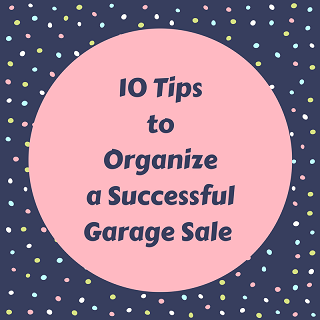 After recently performing the task of de-cluttering your spaces, and ‘spring cleaning’ to refresh the inside of your home, you probably found a myriad of items that you want to discard. There are a lot of ways to recycle items, most of which is to donate these items to a worthy cause. However, some items have more monetary value than others, and you may want to sell them rather than make a donation to receive the tax write-off. In that case, having a garage sale is an option. Other options include, selling items at a consignment shop, or selling them on ebay, but those options are for another day. Today the focus is on how to ‘organize’ a successful garage sale.
After recently performing the task of de-cluttering your spaces, and ‘spring cleaning’ to refresh the inside of your home, you probably found a myriad of items that you want to discard. There are a lot of ways to recycle items, most of which is to donate these items to a worthy cause. However, some items have more monetary value than others, and you may want to sell them rather than make a donation to receive the tax write-off. In that case, having a garage sale is an option. Other options include, selling items at a consignment shop, or selling them on ebay, but those options are for another day. Today the focus is on how to ‘organize’ a successful garage sale.
Some things to consider as you develop your plan:
• Best days of the week – This may be a regional thing, but in the St. Louis area, Wednesdays seem to be the best day of the week to hold a garage sale. Second choice, is on a Saturday, when more people are not working.
• Time of day – Early in the morning is the best time to start your sale, for example, 8 am. If you advertise, expect shoppers to arrive at least 30-60 minutes earlier than the advertised start time. You may want to put ‘No early birds’ in the add to help keep them from showing up early. End time varies, but usually around 1 or 2 pm, sales start to rapidly decline.
• Weather – If you have a garage or a carport, great, no problem. If not, weather plays a huge part in the development of your plan. You need to have a plan B in case it rains. You may want to hold it in your basement or schedule an alternate day if rain is in the forecast.
• Advertising – If you don’t want the expense of paying for an ad, you can post your ad on Craigslist for free, or buy some inexpensive garage sale signs at your local hardware store and post them at strategic locations in your immediate area. Be careful not to violate sign ordinances in your city/subdivision, or they will be removed very quickly after they are posted, and you could possibly be fined.
• Sales help – You need at least 2 people to bargain with shoppers, take in money, and watch to ensure your merchandise does not walk away. There should always be at least one person watching the store at all times.
• Change – Keep a supply of change on hand for each sales person. Fanny packs work great! That way each person has a supply and won’t have to guard a centrally located box. Make a note of the amount of change you begin with, so you can subtract it from the take at the end of the day, to determine how much you made from the sale.
• Pricing – This is a gray area. It’s difficult to know how to price your treasures. If they’re priced too high, they won’t sell, if they’re too low, you won’t make any money. Some shoppers don’t like to barter, but some live for it. You can always drop the prices mid-way through the sale if items are not moving. If your sale is 2 days, you can start out the first day with higher prices, then discount the items the second day if they are not selling. Some items that don’t sell very well are, women’s and men’s clothing, however, kids clothes do pretty well. Tools seem to be a big seller with men. If the items have multiple owners, you, your husband’s, or your kids – use different colored tags, or colored markers for each person to price the items. Remove the tags as the items are sold so you know who sells what.
• Electrical items – Plug in electrical items or have an outlet available to show that the item works. If it does not work, put a tag on the item noting that the item does not work.
• Curb grabbers – Place large items, such as furniture or power tools close to the curb for visibility to draw in shoppers.
• What about the stuff that does not sell? – The most convenient way to be rid of the remaining item’s, is to donate them to your favorite charity. If you have some items that you don’t want to donate and still want to sell, check into a consignment shop or investigate ebay or Craigslist.


